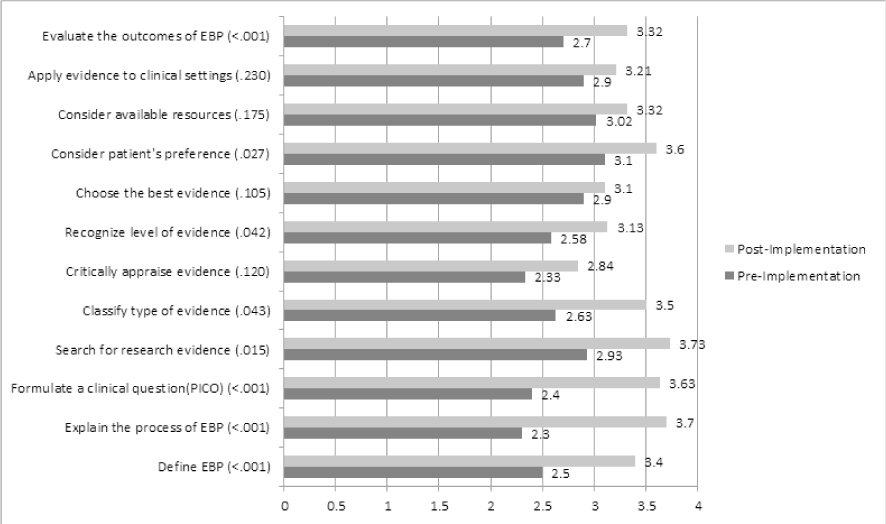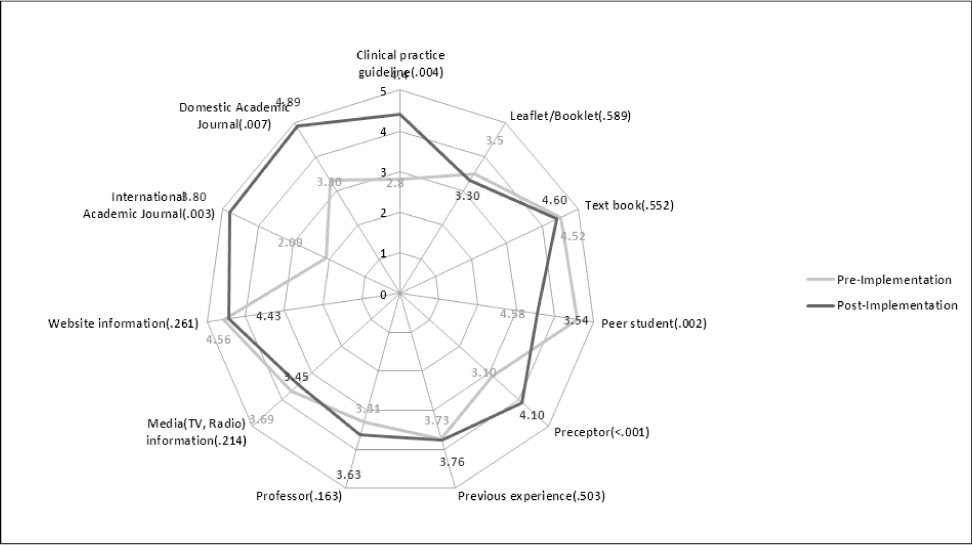J Korean Acad Nurs Adm.
2013 Jan;19(1):39-47.
Implementation of Evidence Based Nursing Education into Nursing Management Clinical Practicum: Outcome Evaluation and Diffusion Strategies
- Affiliations
-
- 1College of Nursing Chungnam National University, Korea. mhpark@cnu.ac.kr
Abstract
- PURPOSE
This practice study was done to describe the process and outcomes of application of Evidence Based Nursing (EBN) Education to nursing management clinical practicum and suggest strategies to diffuse EBN into nursing management education.
METHODS
Education on the evidence based nursing management process was provided to 65 senior nursing students from a university. Nursing management clinical practicum integrated with EBN. The setting was a five full day-clinical practicum. Group and individual training on EBN process with lectures, small group discussions, conferences, and educational prescription were provided. Outcomes were analyzed using paired t test for 65 participants.
RESULTS
Evidence based nursing competency increased significantly showing improvement in understanding EBN, formulating clinical question, searching & classifying the evidence, recognizing level of evidence, considering patient preference, and evaluating outcomes. Nursing students' access and use of evidence based information resource also improved.
CONCLUSION
The results of this study indicate that the application of EBN to nursing management clinical practicum is effective to improve EBN competency in undergraduate students and should be further applied in nursing education using the systematic strategies.
Keyword
MeSH Terms
Figure
Reference
-
1. American Association of Colleges of Nursing. The essentials of doctoral education for advanced nursing practice. 2006. Retrieved November 1, 2012. from http://www.aacn.nche.edu/publications/position/DNPEssentials.pdf.2. Aronson BS, Rebeschi LM, Killion SW. Enhancing evidence bases for interventions in a baccalaureate program. Nurs Educ Perspect. 2007. 28:257–262.3. Association of American Medical Colleges. Advancing educators and education: Defining the components and evidence of educational scholarship. 2007. Retrieved November 3, 2012. from https://members.aamc.org/eweb/upload/Advancing%20Educators%20and%20Education.pdf.4. Boruff JT, Thomas A. Integrating evidence-based practice and information literacy skills in teaching physical and occupational therapy students. Health Info Libr J. 2011. 28:264–272. http://dx.doi.org/10.1111/j.1471-1842.2011.00953.x.5. Cohen J. Statistical power analysis for the behavioral sciences. 1988. 2nd ed. Hillsdale NJ: Erlbaum.6. Cronenwett L, Sherwood G, Barnsteiner J, Disch J, Johnson J, Mitchell P, et al. Quality and safety education for nurses. Nurs Outlook. 2007. 55:122–131. http://dx.doi.org/10.1016/j.outlook.2007.02.006.7. Dawley K, Bloch JR, Suplee PD, McKeever A, Scherzer G. Using a pedagogical approach to integrate evidence-based teaching in an undergraduate women’s health course. Worldviews Evid Based Nurs. 2011. 8:116–123. http://dx.doi.org/10.1111/j.1741-6787.2010.00210.x.8. De Cordova PB, Collins S, Peppard L, Currie LM, Hughes R, Walsh M, et al. Implementing evidence-based nursing with student nurses and clinicians: Uniting the strengths. Appl Nurs Res. 2008. 21:242–245.9. Fetter MS. Curriculum strategies to improve baccalaureate nursing information technology outcomes. J Nurs Educ. 2009. 48(2):78–85. http://dx.doi.org/10.3928/01484834-20090201-06.10. Fineout-Overholt E, Johnston L. Teaching EBP: Asking searchable, answerable clinical questions. Worldviews Evid Based Nurs. 2005. 2:157–160. http://dx.doi.org/10.1111/j.1741-6787.2005.00032.x.11. Greiner AC, Knebel E, editors. Health professions education: A bridge to quality. 2003. Washington D.C.: National Academies Press.12. Jang KS, Kim NY, Ryu SA, Kim YM, Chung KH. Effects of collaborative learning on problem-solving processes according to the level of metacognition in clinical practice of nursing management. J Korean Acad Nurs Adm. 2007. 13:191–198.13. Jones SC, Crookes PA, Johnson KM. Teaching critical appraisal skills for nursing research. Nurse Educ Pract. 2011. 11:327–332. http://dx.doi.org/10.1016/j.nepr.2011.03.002.14. McDaniel J, Drew T, Gueldenzopf S, Yang MZ, Davids K, Moch SD. Trying to promote EBP in your school of nursing? Don't overlook non-nursing students! Reflect Nurs Leadersh. 2002. 28:8–9.15. Melnyk BM, Fineout-Overholt E. Evidence-based practice in nursing and healthcare: A guide to best practice. 2011. Philadelphia: Lippincott Williams and Wilkins.16. Moch SD, Cronje RJ. New knowledge discussion groups: Counteracting the common barriers to evidence-based practice. Worldviews Evid Based Nurs. 2007. 4:112–115. http://dx.doi.org/10.1111/j.1741-6787.2007.00091.x.17. Moch SD, Cronje RJ, Branson J. Part 1. Undergraduate nursing evidence-based practice education: envisioning the role of students. J Prof Nurs. 2010. 26(1):5–13. http://dx.doi.org/10.1016/j.profnurs.2009.01.015.18. Morrow-Howell N, Noelker LS. Raising the bar to enhance the research-practice link. Gerontologist. 2006. 46(3):315–316.19. National Evidence-based Healthcare Collaborating Agency. Vision and mission. 2012. Retrieved November 8, 2012. from http://www.neca.re.kr/intro/vision.jsp.20. Navedo DD. A descriptive study of nursing judgment in senior nursing students: And the relationship with reflective judgment. 2006. Boston: Boston College;Unpublished doctoral dissertation.21. Newhouse RP. Collaborative synergy: Practice and academic partnerships in evidence-based practice. J Nurs Adm. 2007. 37:105–108.22. Oh EG, Kim SK, Kim SS, Kim S, Cho EY, Yoo JS, et al. Integrating evidence-based practice into RN-to-BSN clinical nursing education. J Nurs Educ. 2010. 49(7):387–392.23. Park M. Effects of evidence based practice integrated critical care clinical practicum. J Korean Acad Soc Nurs Educ. 2011. 17(3):348–356.24. Sabus C. The effects of modeling evidence based practice during the clinical internship. J Phys Ther Educ. 2008. 22(3):74–84.25. Sigma Theta Tau International. Evidence Based Nursing position statement. 2005. Retrieved February 15, 2011. from http://www.nuringsociety.org/aboutus/PositionPapers/EBN.26. Stevens KR. Essential Competencies for Evidence-Based Practice in Nursing. 2009. San Antonio: University of Texas Health Science Center Academic Center for Evidence-Based Practice.27. Thompson CJ. Fostering skills for evidence-based practice: The student journal club. Nurse Educ Pract. 2006. 6:69–77.28. Thompson C, MaCaughan D, Cullum N, Sheldon TA, Mulhall A, Thompson DR. Nurses' use of research information in clinical decision making: A descriptive and analytical study. 2004. UK: National Health Service.29. Trangenstein P, Weiner E. Meeting the informatics needs of today's nursing students. Stud Health Technol Inform. 2006. 122:205–210.30. Williamson KM, Fineout-Overholt E, Kent B, Hutchinson AM. Teaching EBP: Integrating technology into academic curricula to facilitate evidence-based decision-making. Worldviews Evid Based Nurs. 2010. 8:247–251. http://dx.doi.org/10.1111/j.1741-6787.2010.00192.x.31. Zhang Q, Zeng T, Chen Y, Li X. Assisting undergraduate nursing students to learn evidence-based practice through self-directed learning and workshop strategies during clinical practicum. Nurse Educ Today. 2012. 32:570–575. http://dx.doi.org/10.1016/j.nedt.2011.05.018.
- Full Text Links
- Actions
-
Cited
- CITED
-
- Close
- Share
- Similar articles
-
- Examining Students’ Experience with the Nursing Management Practicum Based on the Service Design
- Experience of Nursing Students' Therapeutic Use of Self in Web-Based Psychiatric Nursing Practicum Focusing on Role-Playing
- A Phenomenological Study on the Experiences of Nursing Students' Communication in Clinical Nursing Practicum
- The Current State and Future Directions of Clinical Practicum for Adult Health Nursing at Four-year Nursing Colleges in Korea
- Factors Influencing Nurses' Implementation of Evidence-based Fall Management in Geriatric Hospitals




